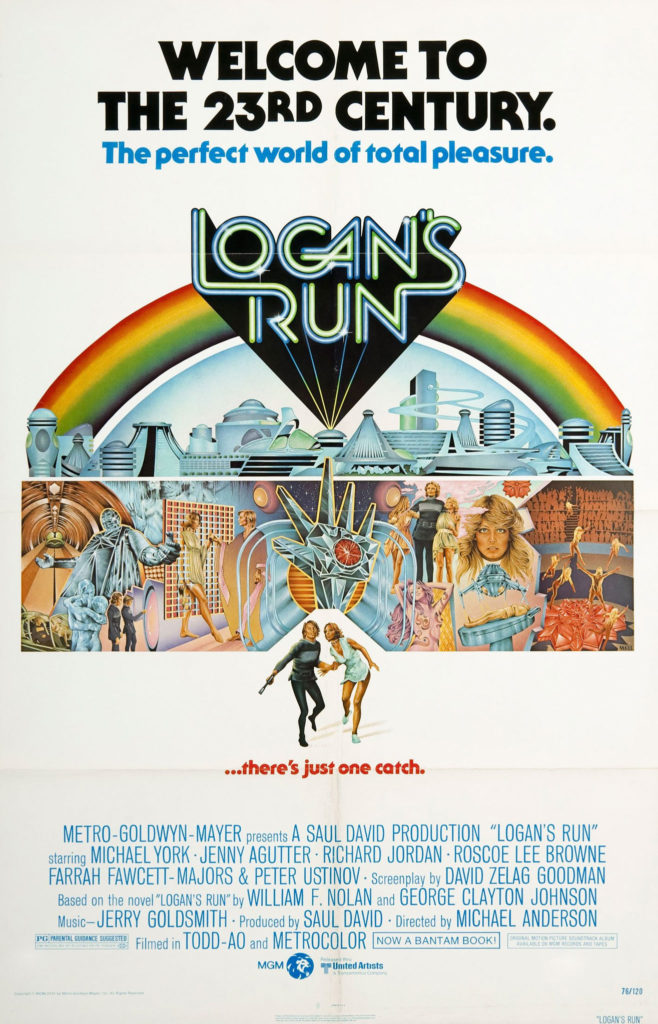Once again, the future is a terrifying place. This is a lesson that Hollywood continues to hammer home to moviegoers. Whether or not anyone is listening...well, that will be evident when we finally arrive in the future, won’t it? If the future is a place packed full of brain-eating zombies, cold-blooded murderous cyborgs, endless desert landscapes blasted with nuclear radiation, gigantic mutated insects, alien slave drivers, and any other myriad threats to the existence of mankind, then we have obviously failed to protect ourselves. Heed the warnings of science fiction, fair citizen, for to ignore them is to sow the seeds of our own destruction.
It’s not all bad, however. In the 1976 film Logan’s Run, the future is a domed city resplendent with idle play free from all worries. Sex can be dialed up with a remote control, and there is a fast and efficient public transportation system that everyone uses. Truly a utopia. But, as I write this, as a mature man aged thirty-two years, I would not only find myself unwelcome under the dome, my very existence would be a capital offense. The bargain imposed upon the citizens of the dome for their carefree lives is to relinquish those lives upon turning thirty. There’s always a catch.
Upon a person’s thirtieth birthday, they are expected to participate in a pseudo-religious ceremony of reincarnation called Carousel, which is in fact a trap designed to get thirty-year-olds to willfully commit suicide so population levels can be maintained in equilibrium. No one knows this, however. Those individuals who show an unreasonable desire to live and refuse to participate in Carousel are called runners.
Logan, the title character played by Michael York, has a unique job. He is a sandman, a sort of policeman in the future city, whose job is not to stop crime, for there seems to be none to stop, but to kill runners. Inevitably, Logan finds himself becoming a runner,  and the story follows his attempts to escape the city, accompanied by Jessica, a member of a future sort of underground railroad for runners, played by Jenny Agutter.
and the story follows his attempts to escape the city, accompanied by Jessica, a member of a future sort of underground railroad for runners, played by Jenny Agutter.
Logan and Jessica are being pursued by Logan’s onetime sandman partner, Francis (Richard Jordan). Francis unquestionably obeys the rules of the domed society and feels a particularly sharp sense of confusion and betrayal when he discovers Logan has become a runner.
The story is driven by action, only touching lightly on issues of self-determination and the right to live, despite this being the foundation of the plot. Much of this appears to be intentional. The origins of the domed city are never explained. Its history has been lost to time for all the characters in the film, and their ignorance is shared by the viewer. Additionally, the residents of the dome are innocent and childlike in many ways. Having their every need provided for them their entire lives has left them intellectually lazy, lacking even the deductive processes necessary to adequately question their place, roles, and rights as human beings. It fits that they can’t even form the words to explain any doubts or firm convictions they may have.
In this fashion, Logan’s Run presents some heavy questions. It’s obvious that the founders of the domed city made decisions that defy ethics, to put it mildly. The fate of the individual is substantiated to the welfare of the whole. A person is done away with before they outlast their usefulness, in order for their place to be taken by someone else. Logan risks his life to battle against this horrible convention for dubious reasons, at first, but eventually comes around to a proper way of thinking about the sanctity of life.
The weakness in the story is that it took so long in this fictional future for someone to come along who is so capably individualistic that they are a threat to that society. But that can be ignored. Logan’s Run is science fiction, after all, where anything goes, where outlandish possibilities, even ones that push the boundaries of reason, are the heart and soul of the genre.
Over three decades since release, Logan’s Run is dated. Sets, costumes, and music all scream 1970s. Even when I first saw this film as a child, not even a decade after it was released, it felt dated. A lot of this has to do with the quality of the film itself, not necessarily the time it was made. The shelf life for the look and feel of this film was extraordinarily short, but get past it, or get used to it, and Logan’s Run is entertaining.
Logan and Jessica are characters easy to root for. Most of the tension in the film comes from a viewer’s identification with these two. Seeing them come to a greater understanding of themselves and the world through their struggles is a satisfying experience, as they represent hope for humankind to regain the soul it so obviously lost under the domes.
